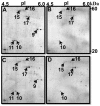Gel-based and gel-free identification of proteins and phosphopeptides during egg-to-larva transition in polychaete Neanthes arenaceodentata
- PMID: 22719953
- PMCID: PMC3376139
- DOI: 10.1371/journal.pone.0038814
Gel-based and gel-free identification of proteins and phosphopeptides during egg-to-larva transition in polychaete Neanthes arenaceodentata
Abstract
The polychaete Neanthes arenaceodentata- is cosmopolitan in distribution-, has been used as a laboratory test animal. Life history of this species has several unique features; the female dies after spawning and the male incubates the fertilized eggs through the 21-segmented stage. The larvae leave the tube and commence feeding. Changes in protein abundance and phosphorylation were examined during early development of N. arenaceodentata. A gel-based approach and gel-free enrichment of phosphopeptides coupled with mass spectrometry were used to identify proteins and phosphopeptides in fertilized ova and larval stages. Patterns of proteins and phosphoproteins changed from fertilized ova to larval stages. Twelve proteins occurred in phosphorylated form and nine as stage specific proteins. Cytoskeletal proteins have exhibited differential phosphorylation from ova to larval stages; whereas, other proteins exhibited stage-specific phosphorylation patterns. Ten phosphopeptides were identified that showed phosphorylation sites on serine or threonine residues. Sixty percent of the identified proteins were related to structural reorganization and others with protein synthesis, stress response and attachment. The abundance and distribution of two cytoskeleton proteins were examined further by 2-DE Western blot analysis. This is the first report on changes in protein expression and phosphorylation sites at Thr/Ser in early development of N. arenaceodentata. The 2-DE proteome maps and identified phosphoproteins contributes toward understanding the state of fertilized ova and early larval stages and serves as a basis for further studies on proteomics changes under different developmental conditions in this and other polychaete species.
Conflict of interest statement
Figures









Similar articles
-
Proteomic changes between male and female worms of the polychaetous annelid Neanthes arenaceodentata before and after spawning.PLoS One. 2013 Aug 30;8(8):e72990. doi: 10.1371/journal.pone.0072990. eCollection 2013. PLoS One. 2013. PMID: 24023665 Free PMC article.
-
Transcriptome and quantitative proteome analysis reveals molecular processes associated with larval metamorphosis in the polychaete Pseudopolydora vexillosa.J Proteome Res. 2013 Mar 1;12(3):1344-58. doi: 10.1021/pr3010088. Epub 2013 Jan 29. J Proteome Res. 2013. PMID: 23294167
-
Phosphoproteome analysis during larval development and metamorphosis in the spionid polychaete Pseudopolydora vexillosa.BMC Dev Biol. 2011 May 25;11:31. doi: 10.1186/1471-213X-11-31. BMC Dev Biol. 2011. PMID: 21612608 Free PMC article.
-
Site-specific degree of phosphorylation in proteins measured by liquid chromatography-electrospray mass spectrometry.Proteomics. 2012 Jul;12(13):2167-78. doi: 10.1002/pmic.201100561. Proteomics. 2012. PMID: 22653803 Review.
-
Protein posttranslational modifications: phosphorylation site analysis using mass spectrometry.Methods Biochem Anal. 2005;45:85-106. Methods Biochem Anal. 2005. PMID: 19235292 Review. No abstract available.
Cited by
-
Transcriptome and proteome dynamics in larvae of the barnacle Balanus Amphitrite from the Red Sea.BMC Genomics. 2015 Dec 15;16:1063. doi: 10.1186/s12864-015-2262-1. BMC Genomics. 2015. PMID: 26666348 Free PMC article.
-
Regulation of developmental processes: insights from mass spectrometry-based proteomics.Wiley Interdiscip Rev Dev Biol. 2013 Sep-Oct;2(5):723-34. doi: 10.1002/wdev.102. Epub 2012 Dec 6. Wiley Interdiscip Rev Dev Biol. 2013. PMID: 24014456 Free PMC article. Review.
-
Proteomic changes between male and female worms of the polychaetous annelid Neanthes arenaceodentata before and after spawning.PLoS One. 2013 Aug 30;8(8):e72990. doi: 10.1371/journal.pone.0072990. eCollection 2013. PLoS One. 2013. PMID: 24023665 Free PMC article.
-
Proteomic Changes Associated with Successive Reproductive Periods in Male Polychaetous Neanthes arenaceodentata.Sci Rep. 2015 Sep 4;5:13561. doi: 10.1038/srep13561. Sci Rep. 2015. PMID: 26337980 Free PMC article.
References
-
- Reish DJ, Gerlinger TV. A review of the toxicological studies with polychaetous annelids. B. Mar. Sci. 1997;60:584–607.
-
- Reish DJ, De Callibus K, Dewar J, Bube C. Reproductive longevity in two species of polychaetous annelids. Zoosymposia. 2009;2:391–395.
-
- Reish DJ. The life history of the polychaetous annelid Neanthes caudat (delleChiaje), including a summary of development in the Family Nereidae. Pac Sci. 1957;11:216–228.
-
- Herpin R. Recherches biologiques sur la reproduction et le developpement de quelques annelides polychetes. Bull Soc Sci Nat. l’ouest Fr Sér 4. 1925;5:1–250.
Publication types
MeSH terms
Substances
LinkOut - more resources
Full Text Sources
Molecular Biology Databases

